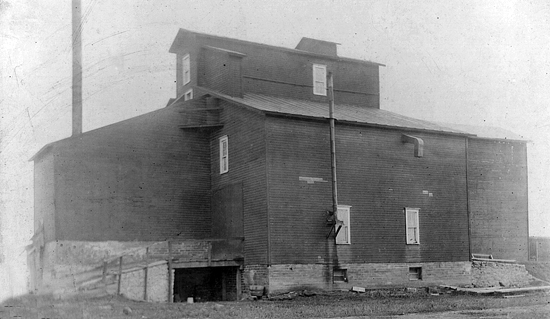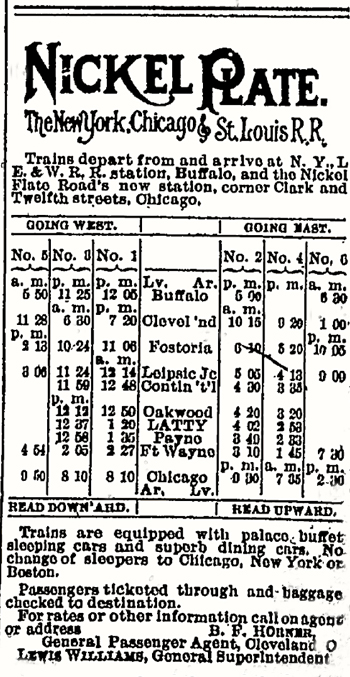Forgotten Paulding County RR towns 3
Editor’s note: This is one of a series of articles in connection with the bicentennial celebration of Paulding County. This is the third of a series of articles on forgotten railroad towns in the county.
KIM SUTTON/for The Van Wert independent
PAULDING — All aboard, as the history of Paulding County railroads and their forgotten towns continues.

The third major railroad to cross Paulding County was the New York, Chicago & St. Louis Railroad. The railroad would change hands and carry many names over the years, but once it was finally up and running, it was most commonly known as the Nickel Plate.
This rail line is still in operation today and is the only active railroad running through Paulding County. Today, it carries the name Norfolk & Southern.
The history of the Nickel Plate is fascinating and there are many good books written on the subject. As the railroad pertains to Paulding County, it is best described in the Historical Atlas of Paulding County, 1892, written by Everett Budd. The local newspapers confirm the author’s account. In part, Budd tells us that, in May 1854, the citizens of Paulding County were surprised when a corps of engineers appeared and commenced construction of a railroad line from Tiffin to Fort Wayne, Indiana.
Shortly after the line was surveyed and located, the road was cut out and partly graded through the county. Work was stopped for the winter and would resume in the spring. Spring came, but with no orders to begin work, and the orders never came. Financial issues with the endeavor caused a permanent suspension of work. Many contractors and employees were unpaid for their labor and suffered a loss.
In 1872, a new company was formed and work began once again on the railroad line. The company, called the Continental Railway, promised a great double-tracked thoroughfare between New York City and Omaha. With high hopes that the railroad would be completed this time, villages began to spring up all along the line.
But lo and behold, misfortune struck again. The company could not pay its debts and in 1874 was forced into a sheriff’s sale of its holdings. Work on the railroad was stopped, and, a second time, county residents were disappointed.
Then in 1881, the railroad project was resurrected by the Seney Syndicate, led by George Seney, with notable associates. One of those associates was Calvin S. Brice, who went to school in Columbus Grove, Putnam County, and was a graduate of Miami University. He would later become a U.S. senator. According to Budd, with a few added facts confirming his account, the story goes that Brice, who was president of the Lake Erie and Western Railroad, was desirous of obtaining an outlet for the freight on his railroad. He wanted to negotiate a deal with the railroad king, William H. Vanderbilt. He requested and received a meeting with Vanderbilt, and inquired about securing a better deal than what he was currently paying. Vanderbilt would not offer him a better deal, and Brice turned upon his heel and said:“I will build a competing line.” Shortly after, work commenced on the New York, Chicago & St. Louis Railroad.
The railroad line was completed through Paulding County in September 1881, and the first train ran over the completed line on October 23, 1882. The third attempt was the charm. The citizens of Paulding County were ecstatic.
The Paulding County Gazette of November 16, 1882, under a column entitled “Oakwood Pencilings,” had this to say: “Our Village is bound to boom vastly this coming summer if present indications hold good. Daily there are parties inquiring for houses to rent. And if there were 20 vacant they would all be rented before the week was out. The Nickel Plate is the cause of it, with our central location, as a village, in a good county.”
When Vanderbilt saw the effect of this “competing line,” he sought control of it and it passed into the Vanderbilt system in 1886. Brice, it is said, cleared a cool $5 million on the deal.
How did the railroad get the nickname “Nickel Plate”? In his book, More Classic American Railroads, historian Mike Schafer states the New York, Chicago & St. Louis Railroad gained its famous nickname, Nickel Plate Road, from a Norwalk newspaper columnist. In the Norwalk Chronicle of March 10, 1881, the columnist complimented the line’s high standard of construction by referring to it as a “double-track nickel-plated railroad.” Nickel plated — a term regarded as indicative of the project’s glittering prospects and substantial financial backing. The name stuck and is still used today.
In Paulding County, the train ran through Oakwood, Melrose, Goodwin, Hedges, Broughton, Latty, Briceton, Worstville, Payne, and Smiley. Two of these towns no longer exist. They are the forgotten towns.
The town of Goodwin, or Goodwin Station/Goodwin City as it was also called, was located between Melrose and Hedges along the Nickel Plate, south of Ohio 613 and along Road 151. The earliest mention of Goodwin was in a publication by Rand McNally in 1895. Goodwin was referenced as having a railroad service and no post office.
The Paulding Democrat dated March 7, 1901, under the column heading “Goodwin Switch”, tells us that “Axel White of Broughton purchased two acres of ground at the Goodwin Station and will erect a large elevator, and that Mr. Shupp will also place a store here. This is a good location for a town and we hope they will hasten the good work.”
Eventually, Goodwin had a grain elevator, a kiln for the making of charcoal, a country store, a blacksmith shop, and several homes. The school for the children was about a mile away, a one-room schoolhouse called McCartney. When the new school was built in Melrose, the children could ride the school bus there. The residents of Goodwin mostly attended church in Melrose.

The Paulding Democrat dated October 30, 1902, states: “Daniel Hudgett of Fort Wayne and Prof. W.F. Griswold and Axel White of Broughton were the original founders of the town now known as Goodwin City.”
A post office was opened at Goodwin on February 25, 1903, and James M. Price was the only known postmaster. The post office was given the name Giauque in honor of Florien Giauque, who was an attorney and a writer of law who lived in Cincinnati, and who invested in real estate in several states. The Paulding Democrat published an article, tongue in cheek, about this development. The headline read “This is No Joke.” The article went on to read: “Goodwin City is booming, but it is Goodwin no more, as the name has been changed to Giauque. After Honorable Florien Giauque, the noted Cincinnati law writer, who owns some six or seven hundred acres of land in that vicinity and is still buying more. Mr. Giauque has his eye on the right side of the value of Paulding County soil and the citizens have done well in naming their little city after the enterprising gentleman. The name is pronounced the same as is spelled, J-O-K-E, Joke.” The post office didn’t last long and was closed on September 30, 1904.
The Goodwin elevator caught fire on August 19, 1923, about 4 a.m. and was completely destroyed. The fire is thought to have been caused from a spark from a locomotive. At the time of the fire, the elevator contained 3,500 bushels of oats, about 1,600 bushels of wheat, and some corn, besides several carloads of hard and soft coal. The elevator was owned by The Wickenheizer Grain Company of Toledo and it was thought that it would not be rebuilt, as they had sold all their other elevators along the Nickel Plate. The fire not only destroyed the elevator, but also a barn, beet shanty, and beet scales. In November of that year, J.C. Harmon & Sons purchased the burned-out property.
The Paulding County Republican reported on June 19, 1924, that the Goodwin elevator was almost complete and it was starting to look like Goodwin again. It was announced in the newspapers on August 1, 1929, that J.E. Wistner had taken over the Goodwin Elevator and was open for business. The little town continued to hang on. The Paulding County Republican of December 17, 1936, announced that Shaffer Bros. would be opening a new store in Goodwin. It was also mentioned that Mr. Giauque was in town again and that his oil well was a boomer.
Neighborhood news continued to come out of Goodwin until about 1948. The elevator had changed hands a few more times. Eventually all was quiet from Goodwin. Today, there are no remnants left of the town.
The next forgotten hamlet is Smiley. Smiley was located about four miles west of Payne situated along the Nickel Plate Railroad just before the Indiana-Ohio state line. The road came in from Edgerton, Indiana, but didn’t go any further than Smiley. It was all woods between Smiley and Payne.
Smiley was a timber town that sat alongside the Nickel Plate railroad. Josiah E. Smiley, who came from Pennsylvania, operated a sawmill and a shingle and basket bottom factory here. A small train station was established at Smiley. There was a church, general store and a tile mill. In its best days the town never had more than about 10 houses.
A post office was established on January 16, 1883, in the home of Smiley, who was the postmaster and, in addition, ran a general store out of his home, located south of Ohio 613 and west of Road 5. There was a school southeast of Smiley, but the path was an oozing muddy mess. Smiley took wood planks from his sawmill and laid them end to end to create a walkway to the school for the teacher and the children.
In 1901, a road was put in from Payne to Smiley and was called the Smiley Pike. Today we know it as Ohio 613. The post office was closed on August 30, 1902, and the residents would receive their mail through Payne.
The tornado that struck on March 29, 1920, and wiped the railroad town of Renollet off the map also struck Edgerton, Indiana, killing four people and destroying the town. The Wesleyan Methodist church that had been moved from Smiley to Edgerton was destroyed. Smiley was heavily damaged as well, but no lives were lost.
By the 1930s, Smiley was no longer mentioned in any of the newspapers. Today, there are no remnants of Smiley.
More information on the bicentennial can be found on Facebook at www.facebook.com/PauldingCounty200.
Next time: Part 4 of the Railroads and Their Forgotten Towns.
POSTED: 05/18/20 at 6:56 am. FILED UNDER: News







